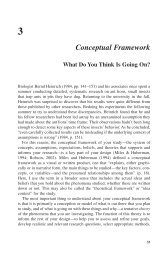Mixed Integer Linear Programming in Process Scheduling: Modeling ...
Mixed Integer Linear Programming in Process Scheduling: Modeling ...
Mixed Integer Linear Programming in Process Scheduling: Modeling ...
You also want an ePaper? Increase the reach of your titles
YUMPU automatically turns print PDFs into web optimized ePapers that Google loves.
154 FLOUDAS AND LIN<br />
RTN based discrete-time MILP model was formulated for the schedul<strong>in</strong>g problem. Harjunkoski<br />
and Grossmann (2001) presented a decomposition algorithm for the short-term<br />
schedul<strong>in</strong>g of large schedul<strong>in</strong>g problems <strong>in</strong> the steel mak<strong>in</strong>g <strong>in</strong>dustry. Lamba and Karimi<br />
(2002b) developed a two-step decomposition algorithm for the short-term schedul<strong>in</strong>g of<br />
a s<strong>in</strong>gle-stage multiproduct facility with multiple semicont<strong>in</strong>uous production l<strong>in</strong>es. The<br />
algorithm is based on item comb<strong>in</strong>ations and is applied to an <strong>in</strong>dustrial problem from<br />
a detergent plant. Castro, Matos, and Barbosa-Póvoa (2002) addressed the schedul<strong>in</strong>g<br />
of a batch digester cook<strong>in</strong>g system of an <strong>in</strong>dustrial acid sulphite pulp mill constra<strong>in</strong>ed<br />
by steam availability. A discrete time RTN based model featur<strong>in</strong>g the most relevant<br />
steam-shar<strong>in</strong>g alternatives was developed and the required process data were obta<strong>in</strong>ed<br />
with a dynamic model of the heat<strong>in</strong>g system. L<strong>in</strong> et al. (2002) presented a systematic<br />
framework for the medium-range production schedul<strong>in</strong>g of a large <strong>in</strong>dustrial polymer<br />
multiproduct plant, which uses a roll<strong>in</strong>g horizon decomposition approach coupled with<br />
the unit-specific event based cont<strong>in</strong>uous-time schedul<strong>in</strong>g formulation.<br />
4. Conclusions and perspectives<br />
In the previous sections, we have presented an overview of the developments of mixed<strong>in</strong>teger<br />
l<strong>in</strong>ear programm<strong>in</strong>g (MILP) based approaches for the schedul<strong>in</strong>g of chemical<br />
process<strong>in</strong>g systems <strong>in</strong> the past decade. It is apparent that significant advances have<br />
been achieved on the follow<strong>in</strong>g important frontiers: (i) development of mathematical<br />
formulations for the effective model<strong>in</strong>g of a wide variety of chemical processes; (ii)<br />
development of algorithms for the efficient solution of difficult MILP models; and (iii)<br />
<strong>in</strong>creas<strong>in</strong>g application of the formal MILP optimization framework to real schedul<strong>in</strong>g<br />
problems <strong>in</strong> process and related <strong>in</strong>dustries. However, further research work is needed to<br />
address classes of important large-scale <strong>in</strong>dustrial applications. More specifically, future<br />
research efforts should be directed to address the follow<strong>in</strong>g important issues.<br />
4.1. Reduction of <strong>in</strong>tegrality gaps<br />
Further efforts are required to reduce and even close the <strong>in</strong>tegrality gap for medium and<br />
large scale schedul<strong>in</strong>g applications. This can be achieved through the development of<br />
better mathematical models with tighter relaxations and/or more effective algorithms that<br />
exploit characteristics of the formulation or actual problem.<br />
4.2. Medium-term schedul<strong>in</strong>g<br />
Most work presented <strong>in</strong> the literature so far has been dedicated to short-term schedul<strong>in</strong>g<br />
or the schedul<strong>in</strong>g of cyclic operations. Much less attention has been paid to medium-term<br />
schedul<strong>in</strong>g which <strong>in</strong>volves a relatively long time horizon and leads to very large scale<br />
problems. Dimitriadis, Shah, and Pantelides (1997) and L<strong>in</strong> et al. (2002) reported two
















